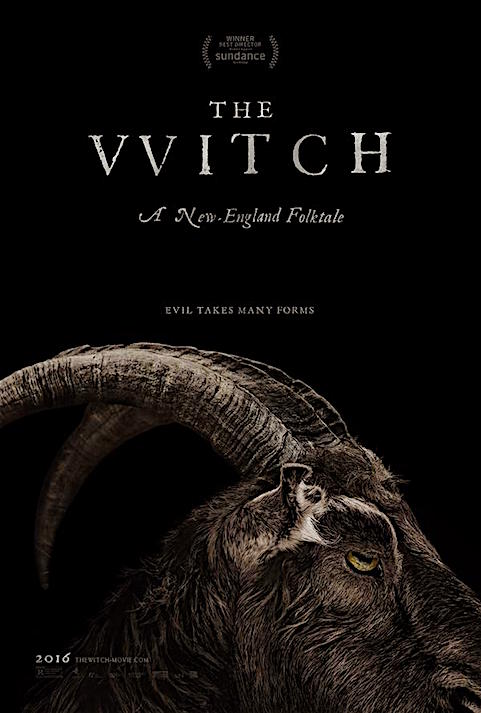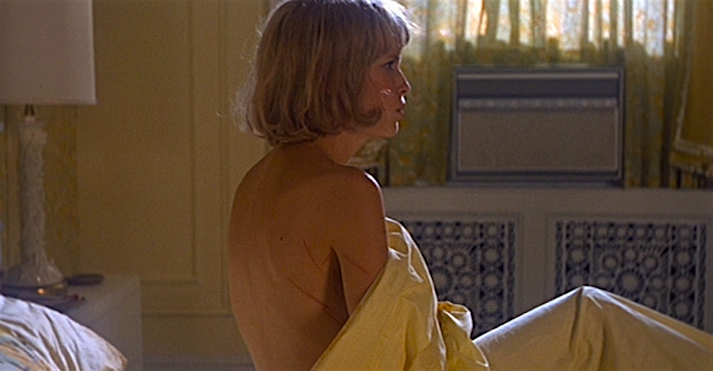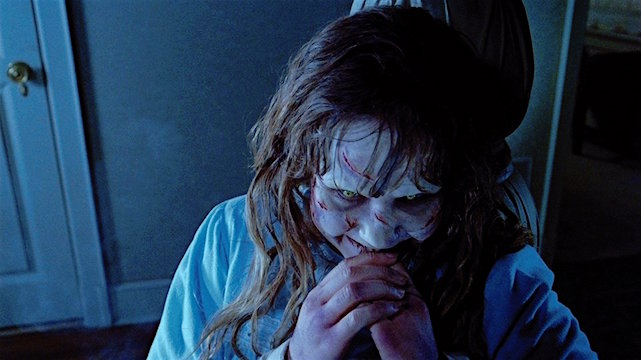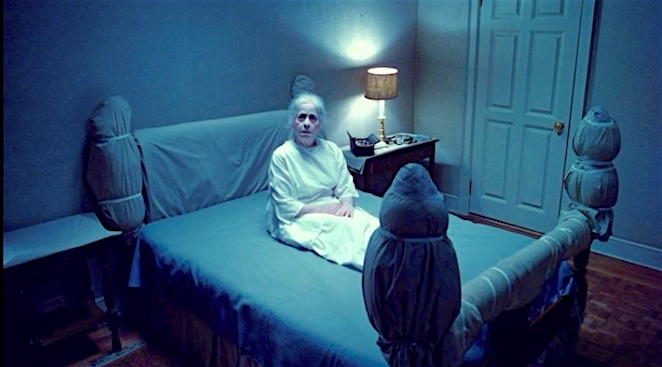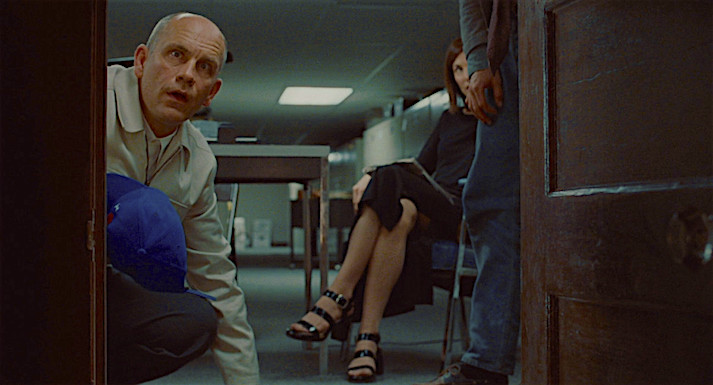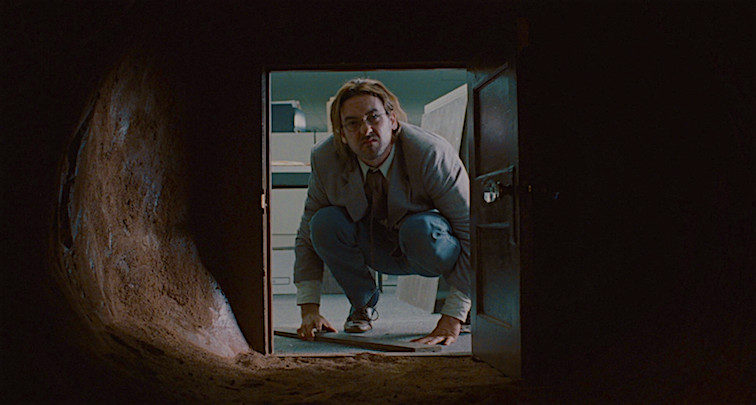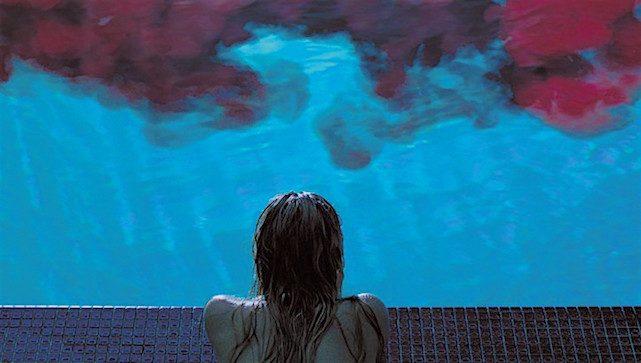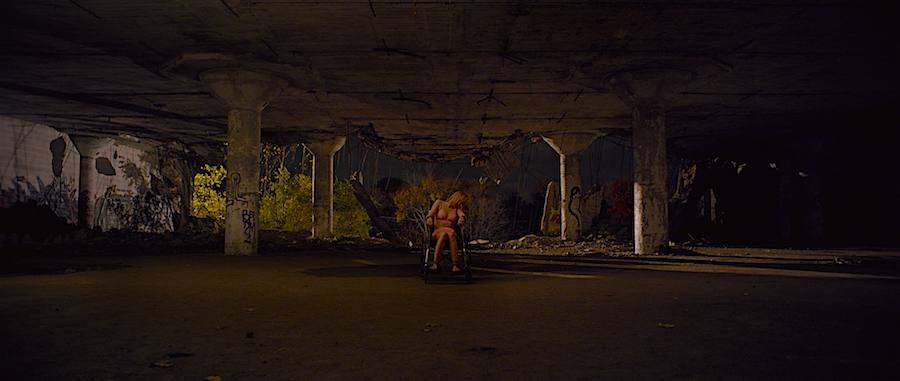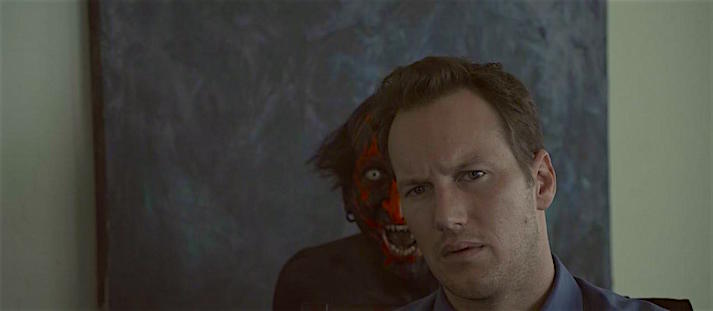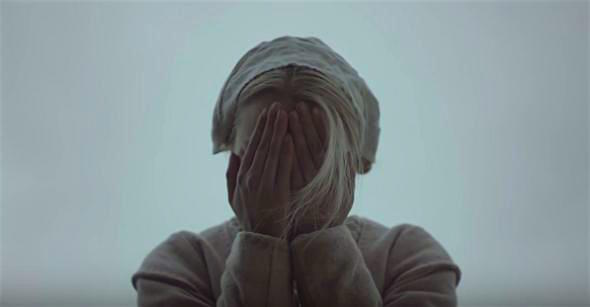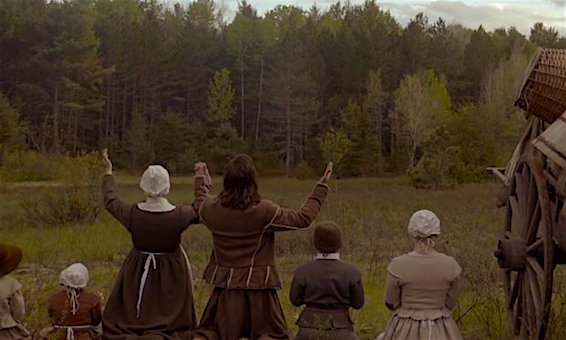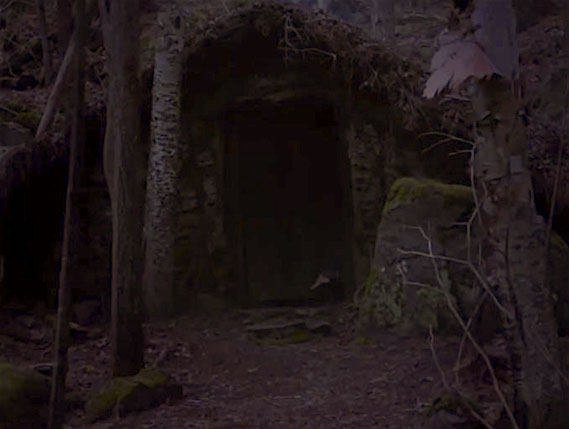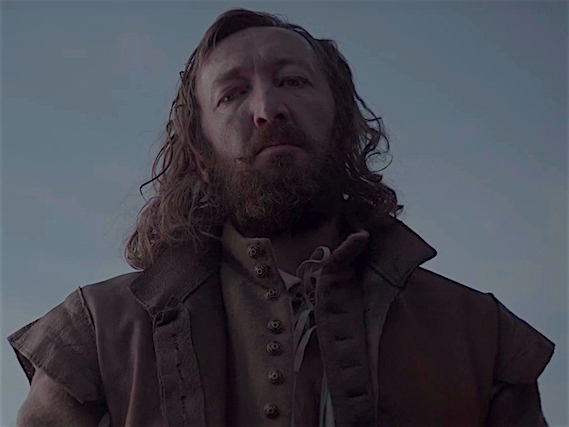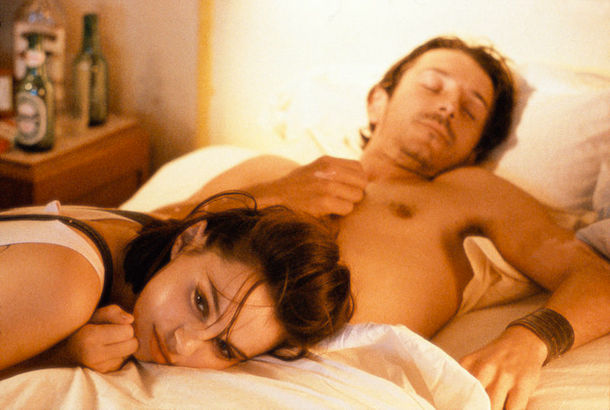I really do not care for the term “Mumblecore.” This term feels like an insult to the films and artists who have emerged within this assigned “genre.” Labels are always problematic. But we humans love to categorize and label. Admittedly I am the first to reject a label assigned to me and often the first to assign one. I do like things to be organized. So just in case you are unaware I will provide definitions and examples for two terms.

The heart and soul gets investigated, critiqued and exposed in Joe Swanberg’s mumblecore Full Moon Trilogy.
JOE SWANBERG: COLLECTED FILMS 2011
DVD Box Set from
Factory 25
http://www.factorytwentyfive.com/joe-swanberg-collected-films-2/
Mumblecore refers to a subgenre of low-budget independent film in which focus is placed on dialogue over traditional plot. Mumblecore films utilize naturalism which is not only limited to dialogue and performance but usually extends to the manner in which production is executed. The concept of plot takes on a sort of organic or even seemingly accidental and it usually revolves around relationship issues clouded by the characters’ inability to articulate individual emotions or the lack of understanding individualistic identities. I have always felt this fairly new subgenre is really an extension of the early La Nouvelle Vague films that come out of France as the 20th Century began to move into the 1960’s. The style of the French New Wave was often less about choice as it was about limited budgets. No matter the intention, this wave of film ushered in whole new manners of speech within cinematic language. Mumblecore has also played a huge influence into the mainstream of film and television.
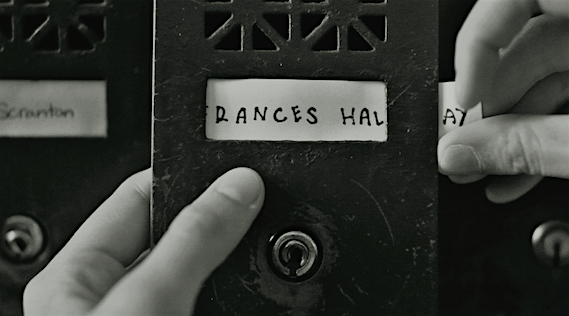
He may have directed it, but Frances Ha ties itself to both Mumblecore and The French New Wave with ease. And it reached a very large audience.
Frances Ha
Noah Baumbach, 2012
Cinematography | Sam Levy
As an example of Mumblecore I offer a film made long before the idea of Mumblecore existed: Eric Rohmer’s Pauline at the Beach (1983) – A highly acclaimed film running for 90 minutes about little more than three irresponsible adults confused about what love is and how to secure it. In this quietly brilliant film, there is no real plot. The dialogue feels improvised. It is the teenage title character who seems to have even a remote understanding of love and life. The film has no visual style. It is slowly paced. But when Pauline leaves and the credits begin to roll an unexpected punch has been delivered. Kentucker Audley’s Team Picture (2007) Andrew Bujalski’s Beeswax (2009) Dustin Guy Defa’s Bad Fever (2012) and Lynn Shelton’s Humpday all lead the audience to similar melancholy conclusions.

Feodor Atkine and Arielle Dombasle have very different ideas related to “love”
Pauline at the Beach
Eric Rohmer, 1983
Cinematography | Nestor Almendros
Meta-Film is also often called Metacinema and it is used to describe films that are either about the filmmaking process, business or movies that dare to break the fourth wall or even present a film within a film. The concept of the Meta-Film is directly related to the literary device of Metafiction. Examples of Meta-Films are Annie Hall, Adaptation, Fight Club, Sunset Blvd, Ferris Bueller’s Day Off, Synecdoche, New York and Mulholland Drive. As you will note the genre, tone and intention of the Meta-Film unlimited. My personal favorite example of the MetaFilm is Francois Truffaut’s acclaimed Day for Night (1973)

“Making a film is like a stagecoach ride in the old west. When you start, you are hoping for a pleasant trip. By the halfway point, you just hope to survive.”
Day for Night
Francois Truffaut, 1973
Cinematography | Pierre-William Glenn
While this film is most certainly dated, it is still very much alive. Truffaut is clearly playing a version of himself as he tries to make a movie while dealing with the many little dramas of his actors and crew threaten to throw the whole production down the drain. What I really love about Day for Night is its total lack of cynicism. Despite all of the troubles the director encounters, there is a love not only for each of the actors playing characters — this movie’s main intention is to serve as a shout out of love for movies and movie making. Day for Night refuses to commit to realism, surrealism or even satire. This quirky little 1970’s movie brims over with the sort of magic that only a film can provide.
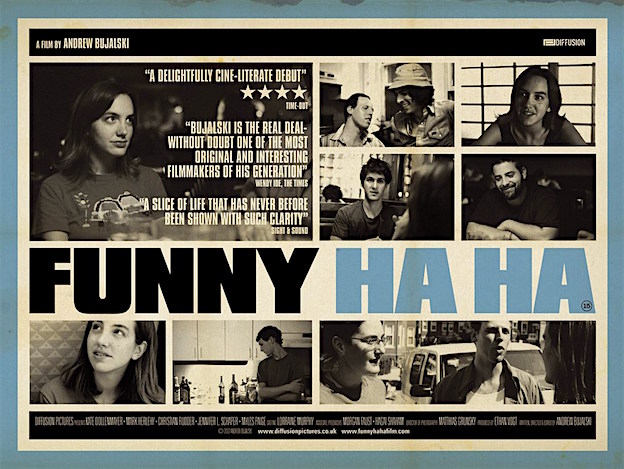
FUNNY HA HA, British poster art, Kate Dollenmayer (top left), Myles Paige (top center), William Westfall (hat), Christian Rudder (center), 2002. ©Goodbye Cruel Releasing
I may not like the label / term of Mumblecore, but I have been an advocate of this group of Film Artists from the beginning. There are some very interesting aspects of this subgenre of Independent Film:
A simultaneous blending of cinematic auteur theory and active collaboration
The development of an artistic community and a loosely formed Acting / Filmmaking Troupe
Continuous exploration of identity
A unique shape of narrative structure
A consistent feeling of a unity between projects no matter how different they might be
As with any labeled genre, there are certain artists who interest me more than others. Among them are Kelly Reichardt, The Duplass Brothers, Kentucker Audley, Josephine Decker, Rick Alverson, Lynn Shelton, Todd Rohal, Amy Seimetz and Michael Tully. It is essential to note that the term “Mumblecore” literally fails when held up to much of what these filmmakers do. Then again I’ve never gotten any sense that these artists worry about coloring outside the lines. Kelly Reichardt’s work is transformative. Rick Alverson’s films always contain a mix of societal criticism interlacing with absurdist or surrealist humor. His most recent film, Entertainment, is dark surreal vision of an artist pushed to the edge of sanity.
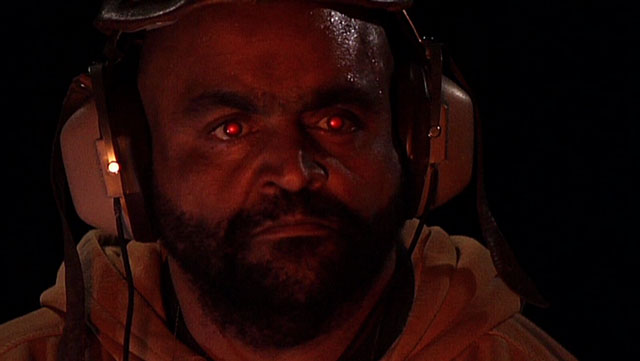
Look it, God will you fuck you up!
The Catechism Cataclysm
Todd Rohal, 2011
Cinematography | Benjamin Kasulke
Michael Tully’s films are always surprising. Each of his films takes the audience to very different places. It is almost impossible to even provide a brief synopsis for his strange breath-taker, Septien. Todd Rohal’s work is always hinged uncomfortably with the Surreal or Absurdist — yet every film he makes manages to resonate. The Catechism Cataclysm, anyone? Amy Seimetz has actually only made one feature length film. However Sun Don’t Shine is so damned brilliant I keep waiting to see when she will make another. Jay and Mark Duplass and Lynn Shelton have already moved the genre into the mainstream without any sense of actually buying into full-on commercialization of what they do. HBO’s recent decision to cancel The Duplass’ Togetherness left a great many upset. Togetherness was the perfect artistic alternative to Lena Dunham’s Girls. The decision to cancel Togetherness will haunt HBO. Girls is a game-changer, but Togetherness was the intelligent result.

Kentucker Audley and Kate Lyn Sheil have good hearts, but they do very bad things.
Sun Don’t Shine
Amy Seimetz, 2012
Cinematography | Jay Keitel
Josephine Decker’s work is perhaps the most resoundingly unique of the Mumblecore Wave. Both Butter On The Latch and Thou Wast Mild and Lovely lead the audience into worlds that only seem familiar. Decker presents both stories with beauty and devastating horror. Each film is tied closely to the ways in which Ashley Connor finds to lens the director’s ideas. Decker’s work might have a connection to a Lynchian-like viewpoint, but there is something completely new found in both of these films. Each is blessed with a female voice that refuses to be restricted by societal norms or political correctness. That folk song might sound pretty and that barn may appear lovely, but Decker pushes us to the conclusion that both have been reconstructed to hide something far more sinister. Decker’s last two films deviate so far from what is considered Mumblecore that I almost hesitate to list her here. However her work is already deeply entrenched in the Mumblecore artistic troupe I do not see how I can leave her out. In truth, her most recent films seem to align closer to Shane Carruth’s work.

Everything learned by tending to the farm. And everything is offering surprises…
Sophie Traub and Robert Longstreet
Thou Wast Mild and Lovely
Josephine Decker, 2014
Cinematography | Ashley Connor
Of these mentioned, Kentucker Audley is the artist who remains triumphantly grounded in a unique vision that so far has remained stridently Mumblecore. Ambitious and determined, Audley always seems to find a way to continue his cinematic explorations. In the process he has established himself as a solid leading man. As an actor, he is really only challenged by Robert Longstreet. As competent in front of the camera as behind it, this is a filmmaker who will continue to thrive.

This makes De Niro’s “Rupert Pupkin” look safe and sane…
Kentucker Audley at the mic
Bad Fever
Dustin Guy Defa, 2011
Cinematography | Mike Gioulakis
But there is another member of the Mumblecore Wave who is riding it with a conviction and an artistic slant that is ever-growing, expanding and convulsing ideas that seem to evolve with each of his cinematic projects. If we are to buy-into the concept of The Auteur, then we must be able to somehow chart a key thread in the work. Most importantly, the audience should be able to notice a growth from that core thread toward increasing achievement. Art is all too subjective and no artist is ever going to be able to make every step perfect. This is not what I mean when I write “increasing achievement.” The auteur filmmaker is by his/her own formation will not allow their work to fall prey to commercial interests or film criticism. The auteur will create the art no matter where it may lead him/her …or his / her audience.

A film can satisfy the mainstream without killing the intent.
Olivia Wilde and Jake Johnson
Drinking Buddies
Joe Swanberg, 2013
Cinematography | Ben Richardson
Joe Swanberg is most definitively an Autuer. And if you doubt a progression in his work you only need check out the films he released in 2011. Joe Swanberg directed 6 films released in 2011. All 6 are of interest and merit, but 3 form a trilogy that I strongly recommend. I’ve always referred to these 3 films as Swanberg’s Full Moon Trilogy. This trilogy not only captures the pursuit of the filmmaker, it shines a fascinating light on the art of filmmaking and psychological puzzle that Meta-Film can create. I am not certain if this is the correct way to refer to them, but for this essay I am going to use the Full Moon label.
Silver Bullets was not the first film Swanberg released in 2011. His first film of that year was Uncle Kent. An established storyboard director / writer for such animated hits as SpongeBob SquarePants as well as a longtime member of the Mumblecore Artistic Troupe, Kent Osborne takes the title role. As “Uncle Kent” he is essentially playing a variation of himself. As is often the case in Swanberg’s films, it is almost impossible to know how much of what we see is based on truth or complete fiction. There is an uneasy feeling that Uncle Kent is serving as a sort of fuzzy staged re-enactment from Osborne’s private life. The acting is that believable. It may not be the case, but this film gives the impression that we are seeing a slanted manipulation of Osborne’s own life.

Reality, identity and situations merge with fiction. Or is it the other way around?
Uncle Kent
Joe Swanberg, 2011
Cinematography | Joe Swanberg
It is an interesting and often voyeuristic proposition. It often feels like we are seeing something that we should not be allowed to see. Kent has a successful and seemingly profitable career as an animator, but he is getting older and is lonely. Part of that loneliness reveals itself to be a product of Kent‘s inability to fully grasp hold of maturity and the soon to arrive mid-life crisis. He does not seem to relate or even know anyone his own age. His co-worker is a good decade younger and while he has a nice home it is furnished like a college student dwelling. It would appear that Kent spends most of his free time surfing the Internet and playing the hyper-sexualized Chatroulette. Watching these random online interactions is both fascinating and uncomfortable. When he meets Jennifer Prediger’s Kate on the site the two make the rather strange choice to not only meet up, but for her to visit and stay with him for a few days while she is in Los Angeles.
This extended adult sleepover sprouts increasingly uncomfortable moments of self-awareness. This is more than a man reluctantly facing the fact that he getting older. Our Uncle Kent is led to the realization that he no longer fits into the world he inhabits. The feeling that he might be missing out on something soon morphs into existential crisis. It is no longer enough to spend his days working on adult-oriented but infantile comedic cartoon, doodling, surfing the Internet, participating in Chatroulette, getting stoned, petting his cat and hoping against hope that a meaningless sexual encounter might lead to something resembling love. There is no resolution for Kent. We leave him stuck in a trap of his own making. There are no signs that he will be able to change the direction of his life, but there are no clear signs that he won’t. Uncle Kent is a sweetly sour experimental film of mid-life awareness.
Uncle Kent‘s idea of sexual freedom and single life is not something to desire. The film is potent and surprisingly entertaining. There are laughs to be found, but there is a dark sea of tears floating just beneath the surface. Most importantly Swanberg creates a film filled with characters that confuse typical cinematic ideas of reality. Where does Uncle Kent‘s fiction end and truth begin? Or has it all been a fiction?

Artists struggle to keep their private relationships separate from the cinematic work with some dire consequences in the first film of The Full Moon Trilogy…
Silver Bullets
Joe Swanberg, 2011
The first of what I believe is correctly called The Full Moon Trilogy came out not too long after Uncle Kent. Silver Bullets is a slow-burn experience into a meditation on the artist, the artistic process and the attempt to maintain relationships throughout. At first glance Silver Bullets appears to be firmly grounded in realism. While the film presents itself as realism, it really does not try to confuse reality with fiction. Even viewers coming to the film with little to no knowledge of Swanberg or Mumblecore will know they are seeing a narrative fictional film. Swanberg has managed to secure both established actors, Jane Adams and Larry Fessenden in supporting roles. They are clearly not playing versions of themselves beyond the fact that both characters are respected actors facing dwindling options as they grow older in a profession obsessed with youth.
But the idea of naturalism / realism is immediately challenged when we first see Kate Lyn Sheil’s Claire. Framed in the left side of the screen she starts to produce animalistic howling and it is here that Swanberg inserts his title card. This is not a horror film, but it is established that is most likely a film is about the making of one. In fact, the horror filmmaker is played by Indie Horror King himself, Ti West. Claire has won the lead role as a female werewolf and West’s Ben is her director. Her life partner is a filmmaker played by Joe Swanberg. Swanberg’s character is named Ethan. He is also a filmmaker who appears to be very unhappy with a film he and Claire have been making. A film that is either so bad he will never release it or is still in a stage of incompletion. This is the third film that Silver Bullets may or may not be about.

Is the latex mask doing something more than cover the skin of its actor?
Kate Lyn Sheil
Silver Bullets
Joe Swanberg, 2011
When an acting pal of Claire‘s arrives fairly unfreshly from Los Angeles, she presents her friendship with a bit of poison.
It is essential to note that the acting work in this film is very naturalistic and real. No wit or major drama. Communications are often muted and seem to oppose the actions the characters take. In a key scene, Claire‘s friend played Amy Seimetz offers a grim bit of advice. In her view, Claire has not yet had enough experience as a film actor. She advises her to go to Los Angeles and work her trade there. As Seimetz’s character abruptly walks away to change her top because she “feels fat,” she offers the observation that it is clear that Claire has not yet gained the required actor training because she still retains hope.
This advice and observation are delivered with sincerity. There is no intended irony or sarcasm. According to Charlie, the life of a working actor does not offer hope. It offers only disappointment and body issues. Yet there is an undertone to Amy Seimetz’s delivery of the lines. (if they are delivered at all — note: it is hard to know if we are seeing something fully scripted or improvised under a rough guideline) It might just be that the friend wants to push Claire away from the business to avoid competition. It is never clear.
As Claire pursues her staring role in a horror film about a predatory female monster, her relationship with Ethan is placed in jeopardy. Her filmmaker boyfriend views her success with jealousy and his interest in her as his muse/leading lady seems to have vanished. Ethan is interested in pursuing Claire‘s friend from LA as his new leading lady. Meanwhile back on the horror movie set, it is clear that Claire is becoming dependent upon Ben‘s attention to help her be successful as his horror film leading lady. There is confusion both on and projecting from the screen about the identities of filmmakers. Is there a difference between serving as a leading lady and being a lover? Does one supersede the other?

Is this a role or a new development in identity and all that relate to it?
Kate Lyn Sheil
Silver Bullets
Joe Swanberg, 2011
This is an experimental film about art and those who create it — and the impact it can have on their lives. It works. As Silver Bullets moves to it’s conclusion disorientation creeps over the entire film. Just when we feel fairly positive we are seeing a fictional narrative film rooted in realism and naturalism, Swanberg pulls the rug from beneath our feet. In a disturbing mix of realism, surrealism and possibly footage from another movie — the audience is left with the conundrum of sorting out the film we thought we were watching from the two others films we know the characters are making. But there is an added idea of psychological horror lurking and bubbling over in true horror film style.
Silver Bullets is a Meta-Film that presents a film within a film within a film and it never fully commits on which film(s) the characters are in during which scenes.
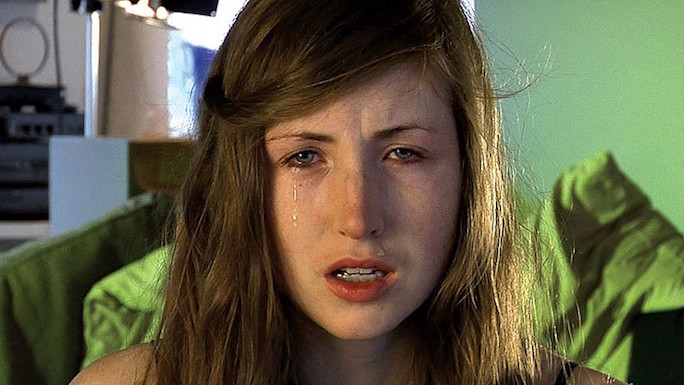
Are these the tears of a broken heart or those of an actor ready for her close-up?
Kate Lyn Sheil
Silver Bullets
Joe Swanberg, 2011
It is not a frustrating result. The film satisfies and when a prologue arrives some questions are answered. But before Swanberg fades his screen to black he tosses a new idea out to the audience — Is Ethan a variation of Joe Swanberg?
The second film in The Full Moon Trilogy is Art History. This is about the making of a movie. That movie appears to be about an extended sexual encounter that becomes an intimate interaction beyond the sexual. Swanberg once again casts himself as a filmmaker directing a movie. While he is playing a character with a different name than his own, he plays it exactly like he played Ethan in the previous film. An unsatisfied and uninspired filmmaker who struggles with his private life as much as with his artistic calling. For Art History he has cast both Adam Wingard and his real-life wife and real-life filmmaker, Kris Swanberg. Wingard is clearly playing himself. He is given no name in the movie, but he is not only playing a cinematographer — he is also serving as Art History‘s co-cinematographer. Kris Swanberg’s role in the production is not articulated, though we know she is pregnant and we are given hints that she is involved with the film director. The two actors are played by Kent Osborne (who is given a different character name, but still seems just like Uncle Kent) and Josephine Decker.

What is going on here?!?! The concept of Meta-Film truly becomes impossible.
Art History
Joe Swanberg, 2011
The puzzle of this Meta-Film begins immediately when the first thing we see is a graphic scene of sexuality. A close-up of Kent Osborne’s penis and Josephine Decker attempting to cover it with a condom. The only clue that this may all be fiction is that Osborne’s penis is not erect. In addition, as Decker mount and grinds, the positioning and POV seem slightly off for the camera to be filming unstimulated sex. Soon enough Joe Swanberg’s character stops the filming for a quick “re-group” on the scene. None of this is presented in an erotic way. This is almost anti-erotic.
Perhaps more than any other Swanberg film, Art History looks truly ugly, unframed and clunky. The acting is first rate and firmly grounded in realism. Both Osborne and Decker seem to be doing their best to become comfortable with each other. But wait, was that re-grouping to help Osborne relax so that he can achieve an erection? Is the sex meant to be unstimulated? The conversing is painfully realistic as are the mutually awkward attempts at touching each other to both stimulate and relax. So, wait. Is this acting? We think it is. Or, hold up. Are these two actors actually involved. Decker seems to be playing the same character who showed up for a three-way with Uncle Kent and Kate in the other movie. Did they develop a relationship during that shoot and this is continuing as an idea for a movie? Where does the film within a film end/begin?

Although working with another actor, director and crew member — Juliette is clearly feeling alone and more than a little lost. What is the point of bothering with the sheet?
Josephine Decker
Art History
Joe Swanberg, 2011
Cinematography | Adam Wingard & Joe Swanberg
Swanberg’s character may be called Sam, but he sure seems like the Joe Swanberg I’ve seen chatting in interviews. As Osborne and Deckers’ characters seem to be warming to each other, Sam becomes jealous. Later it is clear he is developing sexual feelings for Decker’s character. And it looks like Decker is asking Kris Swanberg for relationship advice when it comes down to meeting someone in this sort of circumstance. The video stock looks different. Is this off someone’s cellphone? Was that Decker as Juliette asking Kris Swanberg’s character a question? Or was that Decker and Swanberg having a private huddle that has been edited into the film?

At what point are we in a movie within a movie or possibly a document of the whole process.
Kent Osborne and Josephine Decker
Art History
Joe Swanberg, 2011
Cinematography | Adam Wingard and Joe Swanberg
One could almost accuse Swanberg of No Wave style or having absolutely no style to his filmmaking. In Art History, the absence of style actually begins to feel stylized. Interestingly, Art History contains several of the most stunning shots Swanberg has ever captured. A carefully lit in limited POV we see a swimming pool in which the two actors and director swim nude to relax. These shots serve as pause notations for the film itself. And these brief and artistically sensual shots are completely cinematic. The line between reality and fiction is blurred, but there is a lingering feeling that we are just watching a movie within a movie.
Wait a second. Who is actually swimming nude in that pool? Are these the two actors and one director or are they the three characters? Is this a movie within a movie and a documentary of both all edited together? Is there a difference?

A beautifully sensual shot.
Art History
Joe Swanberg, 2011
Cinematography | Adam Wingard and Joe Swanberg
The beautiful set-up of the swimming pool serves as the place for the film’s final scene. Art History‘s ending raises a whole new level of psychological game play for the viewer. Were the pool shots artistically set or just the blind luck of light and a perfectly placed surveillance camera? Either way, was the final scene real or scripted rage? Did we just see documented rage? When were Kent Osborne and Josephine Decker acting? Were they ever filmed as themselves? Are they consistently acting throughout? Without knowing the artists involved it is impossible to fully know.

Unable to sleep…
Joe Swanberg
Art History
Joe Swanberg, 2011
Cinematography | Adam Wingard and Joe Swanberg
This is the magic of Art History as a Meta-Film. This is also the cinematic moment when no one can deny Joe Swanberg’s talent as a filmmaker. The expression of intimacy is a tricky business for any actor, but within Art History, this challenge seems to be creating a view from almost every angle. There again, maybe it doesn’t. No matter the answer, Art History fully demonstrates an ever growing thread started in Silver Bullets as well as a growing maturity in filming. However Swanberg’s strangest artistic turn is delivered in the final film of The Full Moon Trilogy.

Fictional and Real in their private bedroom, these two actors and fellow filmmakers ponder questions of art, identity and consequence…
Sophia Takal and Lawrence Michael Levine
The Zone
Joe Swanberg, 2011
Cinematography | Adam Wingard and Joe Swanberg
The Zone is the final third film of the trilogy. The first half of this movie plays like a low-rent take on Pasolini’s “Teorema.” Kentucker Audley is the mysterious visitor who is initially introduced as Kate Lyn Sheil’s moody lover. At first it is not clear he is a mystery guest in the house. This understanding is gained when he seduces a more than willing Sophia Takal. Swanberg films the first sexual encounter in a somewhat non-erotic way. While there are many nude shots of the beautiful Kate Lyn Sheil, they do not seem overtly sensual. She and Audley play a strange game which leads to sex, but the whole exchange lacks lust or desire. Both actors appear to be a little bored.
However when it turns out that Sophia Tikal is more than willing to fool around with Kentucker Audley’s character, the tone of their sexual interaction is filmed in a different way. They, too, play a game. The difference is that both characters use the game as a form of flirtation. This sexual intimacy is filmed with a casual sort of lo-fi eroticism. Graphic and interplaying the use of a quilt which highlights gestures of body movements. It is a simple idea, but effective. This sexual encounter is erotic.
When Takal’s real life fiancé arrives home from some sort of sporting event, Kentucker Audley’s character is seated seductively without a shirt. He sips a beer bottle and follows Lawrence Michael Levine into the bathroom where he films Levine’s character taking a shower. Before long it becomes obvious that Audley’s character is putting the moves on Sophia’s soon-to-be-husband. As both remove their pants and the nude Audley walks toward the nude Levine — their images become digitally “ghosted.” We can see through both men. As Audley bends to his knees to pleasure Levine, one can’t help but wonder if the previous realistic film is taking a turn for the surreal. Is this a sexual fantasy or daydream? If it is, to whom does it belong?
At this point Swanberg gives the audience a surprising turn. Suddenly this film becomes an unfinished production with Swanberg, Adam Wingard, Dustin Guy Defa, Kate Lyn Sheil, Sophia Tikal and Lawrence Michael Levine all watching the film we’ve just seen on Swanberg’s laptop. It would appear that the actors are no longer acting. The director is no longer directing. And the co-cinematographer is no longer filming. All five artists begin to critique the film, their work and question the validity of moving forward with the production.
We are to understand that Kentucker Audley has already left and not coming back. His part in the film was finished. One of the actors questions Swanberg’s choice of filming each seduction. All find it problematic that the Kat Lyn and Sophia sex scenes are filmed for long durations without clothing while Lawrence is barely given any nude or sex time. There are also concerns voiced about Swanberg’s choice to not show much of the homosexual encounter and that he has treated it as if it might not have even happened.

Can a happy marriage of two actors handle the sexual confusion of roles?
Sophia Takal and Lawrence Michael Levine
The Zone
Joe Swanberg, 2011
We come to realize two factors of The Zone that are presented in a rather casual ways: Swanberg is filming in the actual home that Sophia and Lawrence share with Kate Lyn. Thus another layer of fiction has been merged with reality. Acting is difficult, but it is even more challenging when the cameras are right up near the face. These are all very talented actors. Finding ways to make sexual intimacy and simulated sex look and appear real is not at all easy. It takes a large emotional toil and can often be more than a little confusing for the actors — even more so if they rely on Method Acting. To simulate sex in their own private house, bathroom, bedrooms and living room would not be any easy feat. Yet all four actors do it very well.
The second factor is revealed in such a flippant and casual manner that I’m not sure I noticed it when I first saw this movie several years back — All four artists discuss Kentucker Audley’s participation in Swanberg’s film as if he had been playing himself. They begin to compare and discuss Audley’s manner and his way of moving into a love scene. Later Michael Lawrence Levin bravely secures an on-screen erection in an attempt to recreate what Swanberg had failed to film with he and Kentucker. At this point the director and the two soon-to-be-married actors try to think of what Kentucker would have done and/or wanted. It is already been made clear that neither Audley or Levine have any interest in homosexual sex, yet that idea that these actors may not really be acting in any traditional sense.
When the four discuss filming a three-way simulated sex scene, the actors speak as if they are really going to be engaging in three-way sex. They do not appear to be talking about acting. They appear to be talking about sharing the sexual experience. Is this a tease of the of the film or do they plan to have full-on sex? Meanwhile, Swanberg shares his fears and concerns about forcing the actors to film something. They assure him that they are participating of their own free will and want to make the best film possible. Swanberg discusses how “certain past filmed scenes” in other films have caused some major hurt and anger. The mind immediately springs back to the closing moments of Art History. As the film within a film continues to challenge its own concept a surprising thing happens while Swanberg films a new scene. The occurrence is unexpected and looks very real. It sounds very real. The panic, rage, hurt and fear do not seem like acting.
When can know we are seeing these five artists acting and when can we know that what we are seeing is an actual documentation of The Zone‘s behind the scenes filming?
We can’t.
But then, Swanberg does something I’ve never seen a filmmaker do — Already having totally disoriented the cast as well as the audience in the ability to understand fictional truth vs. reality truth. Already having inverted the idea of identity beyond recognition — and without warning, The Zone totally implodes upon itself.
We find ourselves in Joe and Kris Swanbergs’ living room. There they are sitting with their newly born baby. Kris is offering Joe criticism of The Zone. She begins to push him to explain what it is he was after. She comments that she has no idea if what she has seen was real. She questions the unexpected moment within the movie as not being valid. Now his wife is questioning the validity of reality vs. fiction. Neither the filmmaker or his filmmaker wife like the movie he had made.

Is this really a film within the film or has it been planned. Does reality fit into this realism?
Kate Lyn Sheil, Dustin Guy Defa, Adam Wingard, Sophia Takal, Lawrence Michael Levine and Joe Swanberg
The Zone
Joe Swanberg, 2011
We reach a true Meta-Film Trip Out when Kris Swanberg notes that Joe has made movie within a movie in which he is questioning his motivations regarding a film within another film that unfolds to another film in which he is still complaining about all of the films — none of which has been fully produced. This is a psychological trap. It could even be called a mind fuck. Swanberg laments he may have reached a dead-end. It is a profoundly disorienting scene. Especially when you take into account that this final Meta-Film Twist may have been scripted.
While watching the final moments of The Zone I can’t help but wonder if we were really seeing the Swanberg living room. Is it a set? What’s up with the odd blue light emitting from the gap in the curtains? How is a couple with a baby able to live in such a minimal room?
In the end Joe Swanberg’s Full Moon Trilogy is a brilliant success. One does not need to see all three in sequential order. All three films function independent of one another. But when you see Silver Bullets, Art History and The Zone together you not only see the thread and Swanberg’s progressing evolvement as an Autuer Filmmaker — the viewer experiences is a rewarding and interesting flow of cinematic ideas. These three films offer a thoroughly unique take on human psychology and the impact of fluidly mixing realism with fiction so deeply leads you into a sort of labyrinth.
If you’ve not seen Joe Swanberg’s Full Moon Trilogy and would like to check it out:
The DVD Box Set is available from Factory 25
Or you can rent or purchase all three from Vimeo
If you are a member of Fandor, all three films are currently streaming as of April, 2016
Matty Stanfield, 4.7.16






